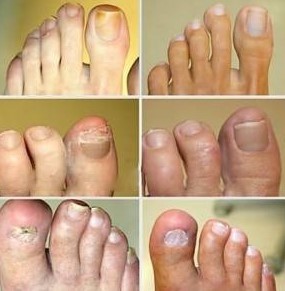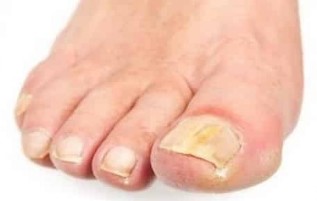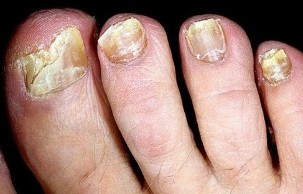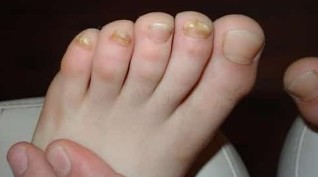Onychomycosis – pathology is, which destroys the nails of the plaza. The fungus eats keratin – construction of base of the nail. The infection enters the intercellular space and begins its division. In the stages of pathology is may affect the skin stop, interdigital area of the heel.

Causes the fungus of the nails of the feet
Get onychomycosis fairly easy. The infection may be lurking on the beach, in the public shower, in the swimming pool. High probability of getting the fungi from the infected family members or acquaintances (the use of the total resources of household items).
There are several of the main premises, which are capable of causing the penetration of the virus in the human body:
- a weak immune system – decrease of the defenses to a cause of the diseases borne infectious or inflammatory in nature;
- pathology is one of the blood vessels (occlusion of the veins) of the violation of work of the internal organs (diabetes mellitus), which lead to problems with the circulation of the blood in the lower extremities;
- small damages in the skin on the feet (abrasion, tear, calluses appear, corn), arising as a result of wearing the narrow shoe;
- the denigration of contact dermatitis of the diaper and the intense sweating of the lower extremities;
- non-compliance of the precautionary measures – test of the shoes of the other, the visit to a public place without the whole, and the neglect of the hygiene of the feet.
Types of nail fungus
Onychomycosis can cause various types of fungi. Exerts the action antifungal, for example, manifest themselves in the form of clouding of the nail. We observe the formation of yellow spots on the edges or in the center of the square. In addition, we can observe longitudinal band along the affected area.
The fungus of the yeast causes the deformation of the surface of the nail. It thins and begins to move away from his place, becomes grayish. The change of the substances in injured cells deteriorates nails roller appear grooves. In addition, in the surrounding area of the epidermis appears the inflammation, swelling, redness, observed the disappearance of the nail of the skin.
Mold bacteria can damage the nail plate, if there are already diseases that cause eating disorders of the nails. In this case also occurs clouding of the square, the color change (pale yellow and greenish to brown and even black).
To know the cause and agent of negative changes in the skin and nails, you should consult a specialist. Independent of the definition of the disease and its treatment without consulting with your doctor can be of consequences.
The stage of the disease

Mycosis of the nails affects healthy cells little by little. The disease has several stages of development, each characterized by its own manifestations.
The first phase of the onychomycosis (normotroficheskie) has no manifestations. In most of the cases it goes unseen. The first symptoms are the nail a little goes changing of their color, are formed micro-cracks and yellow stains in the form of circles or of choice, it appears tuberosity. Beginner the fungus may be accompanied by itching and burning. Properly recognize the infection in the beginning stage is difficult, since the symptomatology is similar to other diseases (psoriasis, of the pathology is of the liver).
If the time does not begin treatment, the disease enters the next phase – the hypertrophic. The nail becomes reinforced shank, dark. Occurs the deformation of the plate, their crumbling and destruction.
Started the shape of the nail disease is manifested by a strong thinning of the surface of the nail, which leads to greater rejection. Garden of winter, the skin gets blue, it appears the bad smell.
The symptoms of the
Onychomycosis most often affects the toenails, they are less likely to suffer from the hand. The disease begins with the thumb and the little finger (hit the outer edge), gently hitting all the panels.
Determine an infection will help the core symptoms of onychomycosis:
- the appearance of stripes and spots of white or green shade under the nails;
- the opacity of the square, the change of their color (from yellow to dark brown);
- the redness and flaking of the skin around the nail;
- the appearance of irregularities on the soles of the feet and between the fingers;
- the formation of mold on the nails.
Types of fungal diseases of the nails
Onychomycosis is accepted to classify on the appearance of the affected areas. Since that classifies a symptom is as you see the fungus in the nails, he distinguishes three types, depending on the clinical manifestations of:
- atrophic, or animalisticheskih – that nail square is shocked, until the degree of rejection of the nail bed;
- hypertrophic type that has lost the natural shine of the nail changes color (blanquece or, on the contrary, it darkens) and the structure (more severe is complicated by the emergence of all kinds of strains and even destroys the edges;
- normotroficheskie – type, characterized by the low of the defeat, in which nails of the plaza does not thicken, becoming glossy and soft, but outwardly is transformed due to the appearance in it of the stains, streaks and other visible changes of their natural transparency and colour.

In other countries, there is another classification, according to which the fungus in the nails is subdivided into types, depending on the location of the defeat:
- total, that pathogens, the process of covering the nail of the square;
- distal – the manner of the defeat, containment only in the free edge of the nail, which acts on the thumb;
- proximal, which destroys the edge of the plate to escape from underneath a roller (opposite the free edge of the nail!);
- side the form of the defeat, which affects the sides of the surface of the nail.
As can be seen the pathology is
Common among the population of the mycoses of the nails have a similar external with other dermatological diseases negribkovoy of nature. Depending on the stage of the pathology is, the nails begin to look healthy, because they lose the natural shine and transparency. Soft and smooth, become thick and deformed, and are covered in different colors (most often white or dirty-yellow) attack. The soft tissues surrounding destructible parasite of the keratin layer are also involved in inflammatory reactions, swelling and izyaslavs.
If it is considered that the image of the destruction of the surface of the nail in view of the dynamics of the disease, it can be divided into a sequence of three stages:
- In the first stage there is no indication that, in addition to easy to tarnish, spots or stripes on the disk.
- In what is known expressed stage, quickly the change of initial, all the symptoms of onychomycosis is evident.
- Initiated the phase is the limit of the degeneration of the nail, can be complemented with the appearance of odours from the decomposition of the tissues.
The causes of the deformation of the nail
To the south of salta, yeast fungi and mushrooms-exerts the action antifungal to cause infectious diseases of the nails (onychomycosis), manifest similar symptoms. All types of nail fungus in the feet or hands deformed the plate of the nail, changing its transparency, brightness, and color. The changes of the nail are to be found here not only of onychomycosis, but in the case of injury, chronic paronihii (inflammation of the plaque), psoriasis, eczema, brush, contact dermatitis. Before you make a conclusion about the fungal infection, it is necessary to consider all possible options.
The symptoms of fungus in the
There are different classifications of nail fungus-depending on the type of manifestations may be very different signs and symptoms, therefore, it is very important to determine your (psoriasis, eczema, d stop and dermatophytes which are very similar). Superficial onychomycosis on the fingers manifested almost immediately after the infection, consider the symptoms and signs of fungus in the nails of the feet and palms of the hands:
- Thickness of the plate;
- Fragile, loose, or broken marigolds, not only near the edge, but by the entire surface;
- Distorted shape, a scaly structure;
- The start – up phase- loss of shine and elasticity;
- If the nail turned black (does not take into account, in case when a person works regularly with coloring compositions or mechanical parts);
- The nails are nailed in the skin;
- Begins dizbakterioz, it is possible to the total decay of the immunity, strength, drowsiness;
- The itching between the toes and in the foot, especially pronounced on the child;
- Flaking of the nail, is a very common condition and almost the last step before the complete loss of the nail bed, called onycholysis. You may feel pain in the fingers and discover a bit of bad odor;
- The skin is dry and cracked, the rash appears, it is possible, even the appearance of blood or ichor;
- Stale white or yellow in the circle under the nail, depending on the type of fungus, which can be bright, dim, with its edges and cloudy in the structure.

Before you start the action, it is necessary to minimize the negative effects on the outside environment, resolve the causes of which have been found fungi below the nails of the feet:
- Hot and humid environment ideal for the growth of various microorganisms, try all the time after walks to stop to dry the shoes, use socks made from only natural materials, which provide normal, heat, and ventilation;
- The fungus of the feet often occurs due to poor immunity, you can tread barefoot on the ground, and to get it, to avoid this, take vitamins;
- Common nails can be one of the causes of the occurrence of onychomycosis, limit the procedure until 1 of the session in six months;
- The most difficult output is a fungus, called active spores. They penetrate into the gaps between the nails and fingers can be any amount of time in the sleep phase, and after the cut to grow. Often they are infected in the common areas (swimming-pools, shower cabins, solariums), in the exploitation of the other's shoes, etc
Common types of mycosis stop
There are many ways to become infected by the fungus of the feet, however, is possible only when a direct contact with the deceased. This happens more often during the use of the shoes of the other, or for breach of the rules of personal hygiene. The fungus of the skin on the feet is usually manifested through the destruction of the layer of the dermis, which is reflected in the form of peeling. The defeat of the epidermis, in this case, the infection penetrates in the deeper layers of the skin, destroying its structure.
Modern medicine distinguishes between the following options fungal and the defeat of the stop, each of which can be distinguished from its symptoms and treatment options:
- Athlete's foot interdigital the most common form, such as that manifested by the disease. Symptom usually is located in the interval between 3 and 4 fingers, unless between 4 and 5, it looks like the crack, the colosseum covered in white plastic. From the stratification of the epidermis, and you can assign a certain amount of liquid, peeling out of the borders, as well as the appearance of the symptoms of contact dermatitis of the diaper. Accompanied by signs of interdigital fungus on the feet can weak of itching. This fungus in the toes initially, it may be totally without symptoms, however, in the future it is observed a substantial change in the structure of the skin.
- The fungus squamous giperkineticeski can be distinguished from other species by a strong desquamation and keratinization which affect the epidermis. It is common for people who suffer from different types of contact dermatitis, mainly atopic. This is another type of disease, you can see, what are are the fungi on the feet. The main symptom of the disease is the appearance of erythema, pain of pink before you buy, in the affected section, which has clear limits. Accompanied by a weak feeling of itching, cracks in the feet, to drought, tolerance to pain and discomfort, the yellow of the vegetation, and the defeat of nail plates. Onychomycosis, which normally accompanies this type of fungus, which leads to the categorization of the nails;
- The fungus virus is one of the uncommon kind of infection that affects the epidermis of the feet. Name of the disease received by the formation of vesicles – bubbles of liquid content in the place that then are formed by the erosion of risk for infection. The main characteristics that distinguish fungi vesicles are: the appearance of blisters with a diameter of up to 1 centimeter, as well as the weak itching;
- Worn by a fungus. In the initial stage of a slight flaking on your feet, as well as the appearance of small cracks, apparently affecting only the top layer of the epidermis.
- The fungus disgidroticheskaya, the infection that occurs in medical practice, only 8% of patients infected mycoses. It is located mainly on the outsole and the set of the feet, manifests itself in the form of bubbles, gradually fuse into one, after which occurs the rupture with the consequent formation of the erosion-extensive type. The danger of fungi of this type lies in the possibility of the accession of bacterial infection, since the pathogenic microorganisms easily penetrate through the resultant wound with the medication;
- The athlete's foot intertriginosny occurs not only by itself, but also as an accompaniment of squamous-shaped fungus of the feet. It manifests between the toes stop, it is characterized by itching and burning sensations, contact dermatitis of the diaper and the appearance of erosions;
- Onychomycosis is another common use of the defeat, which is a fungus of the nails of the feet. Usually develops with the free edge of the nail of the square, the initial phase is characterized by the appearance of yellow stains, after which occurs the progression of the disease with indicators and full othozhdeniem of the nail. Often accompanies other forms of fungi defeats;
- The Candida fungus, also known as yeast of the erosion, which is localized in the interdigital space. In this case the fungus in the feet is seen as the concentration of the fossa swollen areas of the skin which may be surrounded by abscesses a small form.


























